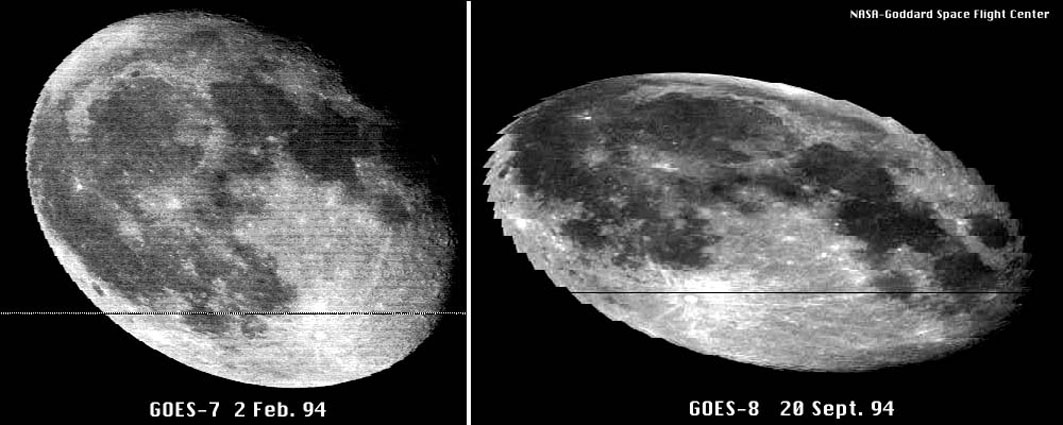Difference between revisions of "May 30, 2004"
| (5 intermediate revisions by the same user not shown) | |||
| Line 1: | Line 1: | ||
__NOTOC__ | __NOTOC__ | ||
=A Weird Moon= | =A Weird Moon= | ||
| + | <!-- Start of content --> | ||
<table width="90%" border="0" align="center" cellpadding="4" cellspacing="2"> | <table width="90%" border="0" align="center" cellpadding="4" cellspacing="2"> | ||
<tr> | <tr> | ||
| Line 12: | Line 13: | ||
</tr> | </tr> | ||
</table> | </table> | ||
| + | <p class="main_sm" align="center">Image Credit: [http://rsd.gsfc.nasa.gov/goes/text/goes8results.html#goes8.moon.20sept94.jpeg NASA-Goddard Space Flight Center], data from NOAA GOES</p> | ||
<table class="story" border="0" bgcolor="#FFFFFF" width="90%" cellpadding="10" align="center"> | <table class="story" border="0" bgcolor="#FFFFFF" width="90%" cellpadding="10" align="center"> | ||
<tr> | <tr> | ||
<td><p class="Story" align="center"><b>A Weird Moon</b></p> | <td><p class="Story" align="center"><b>A Weird Moon</b></p> | ||
| − | <p class="story" align="left">Perhaps the Moon, in racing to circle the Earth in just 27 days, has torqued itself into a new shape. Or maybe the scanning platforms of the GOES weather satellites cause the elliptical and tilted shape. [ | + | <p class="story" align="left">Perhaps the Moon, in racing to circle the Earth in just 27 days, has torqued itself into a new shape. Or maybe the scanning platforms of the GOES weather satellites cause the elliptical and tilted shape. [http://rsd.gsfc.nasa.gov/goes/text/goes8results.html#goes8.moon.20sept94.jpeg NASA scientists] appear to favor the second idea: "The moon looks skewed because the satellite is panning at 15 degree per hour to follow the earth, so that every other scan of background objects appear 4.4 seconds later and eastward in the sequence. The east-west slewing makes groups of two 8-detector scans close together at the west side and far apart at the east side. A comparison between moon shots by GOES-7 and GOES-8 shows how differently the satellites operate, and how much the moon's appearance changes over the months due to variations in the moon's orbit and rotation."</p> |
<p class="story" align="left"><b>Technical Details:</b><br> | <p class="story" align="left"><b>Technical Details:</b><br> | ||
All in the text above!</p> | All in the text above!</p> | ||
<p class="story"><b>Related Links:</b><br> | <p class="story"><b>Related Links:</b><br> | ||
[http://rsd.gsfc.nasa.gov/goes/goesproject.html GOES Science]</p> | [http://rsd.gsfc.nasa.gov/goes/goesproject.html GOES Science]</p> | ||
| − | <p | + | <p><b>Yesterday's LPOD:</b> [[May 29, 2004|Moonsliver over Lyman Hill]] </p> |
| + | <p><b>Tomorrow's LPOD:</b> [[May 31, 2004|Ten Day Old Moon]] </p> | ||
</tr> | </tr> | ||
</table> | </table> | ||
| Line 26: | Line 29: | ||
<p align="center" class="main_titles"><b>Author & Editor:</b><br> | <p align="center" class="main_titles"><b>Author & Editor:</b><br> | ||
[mailto:tychocrater@yahoo.com Charles A. Wood]</p> | [mailto:tychocrater@yahoo.com Charles A. Wood]</p> | ||
| − | < | + | <!-- Cleanup of credits --> |
| − | + | <!-- Cleanup of credits --> | |
| − | < | + | <!-- Cleanup of credits --> |
| − | + | <!-- Cleanup of credits --> | |
| − | < | + | <!-- Cleanup of credits --> |
| − | + | <!-- Cleanup of credits --> | |
| + | <!-- Cleanup of credits --> | ||
<p> </p> | <p> </p> | ||
| − | ---- | + | <!-- End of content --> |
| − | + | {{wiki/ArticleFooter}} | |
| − | |||
Latest revision as of 11:22, 6 June 2015
A Weird Moon
Image Credit: NASA-Goddard Space Flight Center, data from NOAA GOES
A Weird Moon Perhaps the Moon, in racing to circle the Earth in just 27 days, has torqued itself into a new shape. Or maybe the scanning platforms of the GOES weather satellites cause the elliptical and tilted shape. NASA scientists appear to favor the second idea: "The moon looks skewed because the satellite is panning at 15 degree per hour to follow the earth, so that every other scan of background objects appear 4.4 seconds later and eastward in the sequence. The east-west slewing makes groups of two 8-detector scans close together at the west side and far apart at the east side. A comparison between moon shots by GOES-7 and GOES-8 shows how differently the satellites operate, and how much the moon's appearance changes over the months due to variations in the moon's orbit and rotation." Technical Details: Related Links: Yesterday's LPOD: Moonsliver over Lyman Hill Tomorrow's LPOD: Ten Day Old Moon |
Author & Editor:
Charles A. Wood
COMMENTS?
Register, Log in, and join in the comments.




